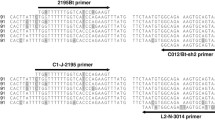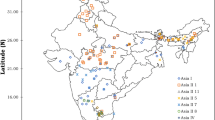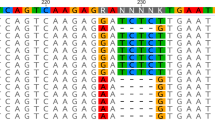Abstract
The recent upsurgence ofBemisia tabaci (Genn.) as an important insect pest and vector ofTomato yellow leaf curl virus (TYLCV) is directly linked to serious damage to tomato crops grown throughout Japan. The molecular genetic identification and phylogenetic relationships of 12B. tabaci populations collected from representative locations in Japan were determined based on the mitochondrial cytochrome oxidase I (mtCOI) sequence. Phylogenetic analysis of the whitefly mtCOI sequence indicated that both the invasive B and Q biotypes now occur in Japan. The Q biotype was found at four locations: Mihara in Hiroshima, Nishigoshi in Kumamoto, Miyanojo and Okuchi in Kagoshima prefectures; the remaining eight collections were identified as the B biotype. This is the first report of the introduction of Q biotype in Japan.
Similar content being viewed by others
References
Brown, J.K. (1994) The Status ofBemisia tabaci (Genn.) as a pest and vector in world agroecosystems.FAO Plant Prot. Bull. 42:3–32.
Brown, J.K. (2000) Molecular markers for the identification and global tracking of whitefly vector-begomovirus complexes.Virus Res. 71:233–260.
Brown, J.K. and Bird, J. (1992) Whitefly-transmitted geminiviruses in the Americas and the Caribbean Basin: past and present.Plant Dis. 76:220–225.
Brown, J.K., Coats, S.A., Bedford, I.D., Markham, P.G., Bird, J. and Frohlich, D.R. (1995) Characterization and distribution of esterase electromorphs in the whitefly,Bemisia tabaci (Genn.) (Homoptera: Aleyrodidae).Biochem. Genet. 33:205–214.
Brown, J.K., Dennehy, T.J., DeGain, B., Rogan, D., Harpold, G., Byrne, F.et al. (2005) First report of the Q biotype ofBemisia tabaci (Gennadius) in the U.S.A. and resistance to insecticides in an Arizona population.European Whitefly Studies Network: http://www.whitefly.org/whiteflyforum/forum_posts.asp?TID=32&PN=1.
Brown, J.K., Frohlich, D.R. and Rosell, R.C. (1995) The sweetpotato or silverleaf whiteflies: biotypes ofBemisia tabaci or a species complex?Annu. Rev. Entomol. 40:511–534.
Costa, H.S. and Brown, J.K. (1991) Variation in biological characteristics and esterase patterns among populations ofBemisia tabaci, and the association of one population with silverleaf symptom induction.Entomol. Exp. Appl. 61:211–219.
De Barro, P.J., Driver, F., Trueman, J.W.H. and Curran, J. (2000) Phylogenetic relationships of world populations ofBemisia tabaci (Gennadius) using ribosomal ITS1.Mol. Phylogenet. Evol. 16:29–36.
De Barro, P.J., Trueman, J.W.H. and Frohlich, D.R. (2005)Bemisia argentifolii is a race ofB. tabaci (Hemiptera: Aleyrodidae): the molecular genetic differentiation ofB. tabaci populations around the world.Bull. Entomol. Res. 95:193–203.
Frohlich, D.R., Torres-Jerez, I., Bedford, I.D., Markham, P.G. and Brown, J.K. (1999) A phylogeographical analysis of theBemisia tabaci species complex based on mitochondrial DNA markers.Mol. Ecol. 8:1683–1691.
Gill, R.J. (1992) The morphology of whiteflies.in: Gerling, D. [Ed.] Whiteflies: Their Bionomics, Pest Status, and Management. D. Intercept Ltd., Andover, Hants, UK. pp. 13–46.
Guirao, P., Beitia, F. and Cenis, J.L. (1997) Biotype determination of Spanish populations ofBemisia tabaci (Hemiptera: Aleyrodidae).Bull. Entomol. Res. 87:587–593.
Horowitz, A.R., Kontsedalov, S., Khasdan, V. and Ishaaya, I. (2005) Biotypes B and Q ofBemisia tabaci and their relevance to neonicotinoid and pyriproxyfen resistance.Arch. Insect Biochem. Physiol. 58:216–225.
Jeanmougin, F., Thompson, J.D., Gouy, M., Higgins, D.G. and Gibson, T.J. (1998) Multiple sequence alignment with Clustal X.Trends Biochem. Sci. 23:403–405.
Kato, K., Onuki, M., Fuji, S. and Hanada, K. (1998) The first occurrence ofTomato yellow leaf curl virus in tomato (Lycopersicon esculentum Mill.) in Japan.Ann. Phytopathol. Soc. Jpn. 64:552–559.
Martin, J.H. (2003) Whiteflies (Hemiptera: Aleyrodidae) — their systematic history and the resulting problems of conventional taxonomy, with special reference to descriptions ofAleyrodes proletella (Linnaeus, 1758) andBemisia tabaci (Gennadius, 1889).Entomol. Gaz. 54:125–136.
Matsui, M. (1992) Irregular ripening of tomato fruit caused by the sweetpotato whitefly,Bemisia tabaci (Gennadius) in Japan.Jpn. J. Appl. Entomol. Zool. 36:47–49 (Japanese, with English abstract).
Muniz, M. (2000) Host suitability of two biotypes ofBemisia tabaci on some common weeds.Entomol. Exp. Appl. 95:63–70.
Nauen, R., Stumpf, N. and Elbert, A. (2002) Toxicological and mechanistic studies on neonicotinoid cross resistance in Q-typeBemisia tabaci (Hemiptera: Aleyrodidae).Pest Manag. Sci. 58:868–875.
Ohto, K. (1990) [Occurrence of the sweetpotato whitefly,Bemisia tabaci (Gennadius), on the poinsettia.]Shokubutuboueki 44:264–266 (in Japanese).
Ozaki, T., Kobatake, H. and Inoue, T. (1976) Tomato yellow dwarf disease transmitted byBemisia tabaci.Shokubutuboueki 30:458–462 (Japanese, with English abstract).
Pascual, S. and Callejas, C. (2004) Intra- and interspecific competition between biotypes B and Q ofBemisia tabaci (Hemiptera: Aleyrodidae) from Spain.Bull. Entomol. Res. 94:369–375.
Rosell, R.C., Bedford, I.D., Frohlich, D.R., Gill, R.J., Brown, J.K. and Markham, P.G. (1997) Analysis of morphological variation in distinct populations ofBemisia tabaci (Homoptera: Aleyrodidae).Ann. Entomol. Soc. Am. 90:575–589.
Ueda, S., Takeuchi, S., Okabayashi, M., Hanada, K., Tomimura, K. and Iwanami, T. (2005) Evidence of a newTomato yellow leaf curl virus in Japan and its detection using PCR.J. Gen. Plant Pathol. 71:319–325.
Zhang, L.P., Zhang, Y.J., Zhang, W.J., Wu, Q.J., Xu, B.Y. and Chu, D. (2005) Analysis of genetic diversity among different geographical populations and determination of biotypes ofBemisia tabaci in China.J. Appl. Entomol. 129:121–128.
Author information
Authors and Affiliations
Corresponding author
Additional information
http://www.phytoparasitica.org posting July 21, 2006.
Rights and permissions
About this article
Cite this article
Ueda, S., Brown, J.K. First report of the Q biotype ofBemisia tabaci in Japan by mitochondrial cytochrome oxidase I sequence analysis. Phytoparasitica 34, 405–411 (2006). https://doi.org/10.1007/BF02981027
Received:
Accepted:
Issue Date:
DOI: https://doi.org/10.1007/BF02981027




